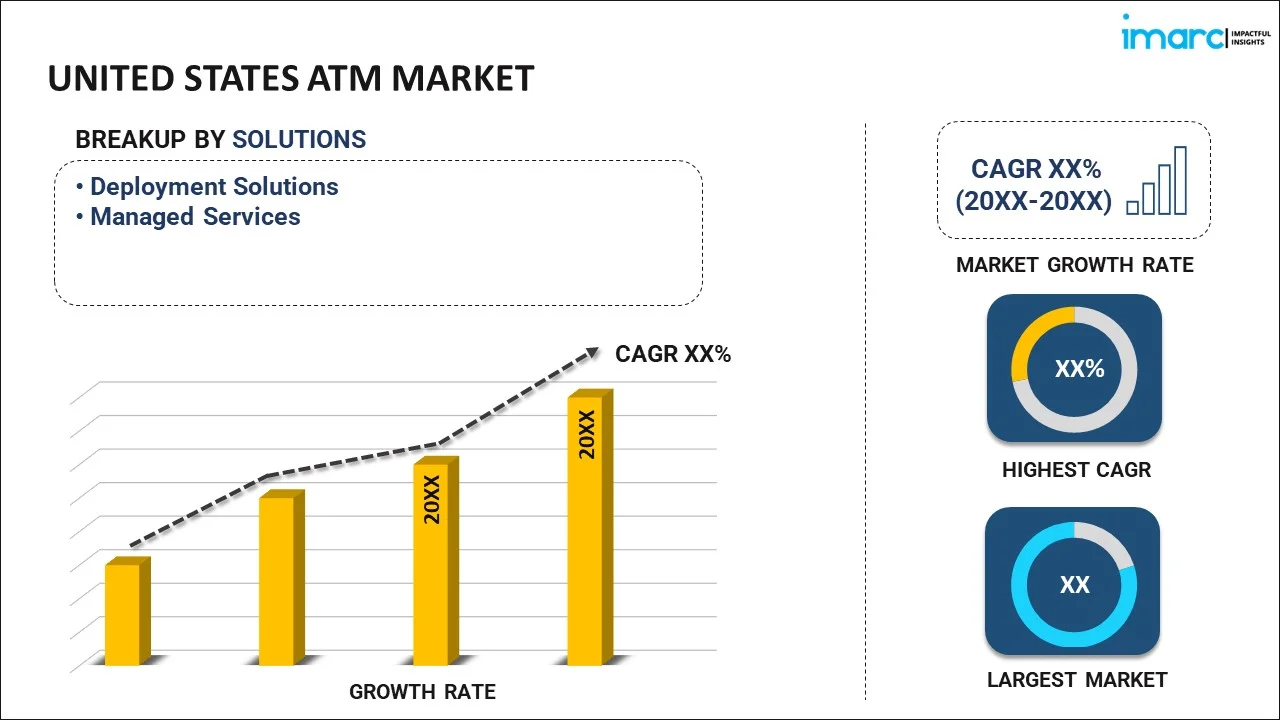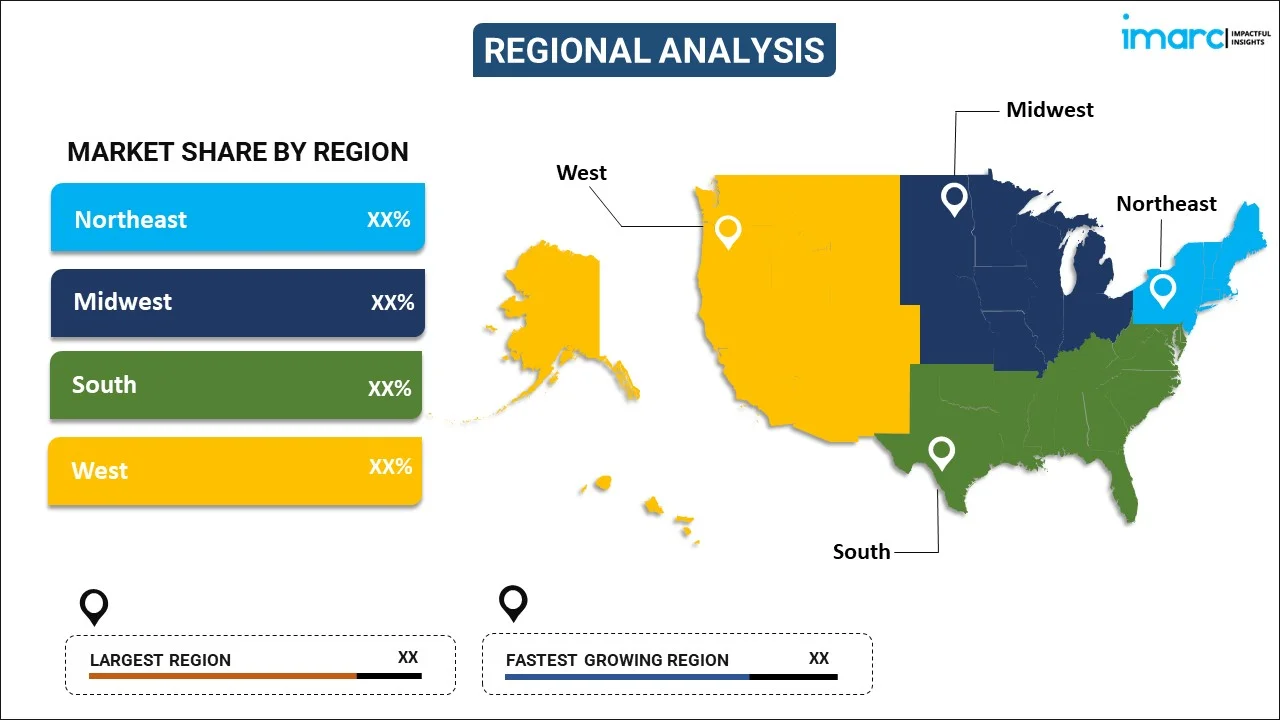
United States ATM Market Report by Solution (Deployment Solutions, Managed Services), Screen Size (15" and Below, Above 15"), Application (Withdrawals, Transfers, Deposits), ATM Type (Conventional/Bank ATMs, Brown Label ATMs, White Label ATMs, Smart ATMs, Cash Dispensers), and Region 2025-2033
United States ATM Market Size:
The United States ATM market size reached USD 8.1 Billion in 2024. Looking forward, IMARC Group expects the market to reach USD 12.6 Billion by 2033, exhibiting a growth rate (CAGR) of 4.6% during 2025-2033. The market is experiencing steady growth driven by the increasing demand for convenient cash access, favorable regulatory changes promoting financial inclusion, rise in travel and tourism activities, rapid expansion of banking networks, considerable growth in retail and e-commerce sectors, and the adoption of cash recycling ATMs.
|
Report Attribute
|
Key Statistics
|
|---|---|
|
Base Year
|
2024
|
|
Forecast Years
|
2025-2033
|
|
Historical Years
|
2019-2024
|
|
Market Size in 2024
|
USD 8.1 Billion |
|
Market Forecast in 2033
|
USD 12.6 Billion |
| Market Growth Rate 2025-2033 | 4.6% |
United States ATM Market Analysis:
- Major Market Drivers: The primary drivers of the market include the increasing demand for convenient cash access, technological advancements in ATM systems, regulatory changes promoting financial inclusion, and the expansion of banking networks. Additionally, the rise in tourism and domestic travel, growth in retail and e-commerce sectors, enhanced security features, and the adoption of cash recycling ATMs significantly contribute to market growth.
- Key Market Trends: Technological advancements are shaping the future of the ATM market, with innovations such as biometric authentication, contactless transactions, and real-time maintenance alerts becoming standard features. The integration of AI and machine learning for predictive maintenance and enhanced security measures are also notable trends. Additionally, the deployment of multi-functional ATMs that offer services beyond cash withdrawals, such as bill payments and fund transfers, is on the rise, aligning with broader digital transformation trends in the banking sector.
- Geographical Trends: The placement of ATMs in strategic locations across various geographical regions is critical to market expansion. Larger concentrations of potential users of ATM services are typically found within airports and hotels, shopping complexes and consumers’ favorite tourist destinations. Rural markets have also seen rising ATM deployment due to the policies that particularly encourage the provision of banking services to everyone, regardless of geographical location.
- Competitive Landscape: The leading companies are investing in technology advancements, partnership, and networks to consolidate their positions in the market. They are also using capital in the innovation and implementation of better technology in the ATM systems including the cash recycling ATMs to increase efficiency of cash handling, reducing operational cost thus increasing on the competitiveness of the firm.
- Challenges and Opportunities: The current threats to the growth of the market include rising competition, pressures to try to conform to regulatory requirements, and the constant pressure to update technology applied in the market. The need for enhanced security solutions and the increase in ATM branch locations in emerging and rural markets, coupled with the implementation of newer technologies, such as artificial intelligence and machine learning are the significant opportunities for growth.
United States ATM Market Trends:
Increasing demand for cash access
The increasing demand for easy access to cash is consequently driving the market in United States. A significant portion of the population still relies on cash for their daily expenses despite digital transactions and mobile banking. ATMs provide a convenient and fast way to get cash out, especially in rural areas, which are unbanked. With the continuous demand for cash accessibility, there has been an increased deployment of more ATMs across different locations from cities to distances where customers are able to withdraw their funds whenever necessary. Furthermore, continual developments in ATM technology such as improved security features and multi-functionality are making them the best choice both for consumers and financial institutions.
Technological advancements in ATM systems
Technological advancements are another significant factor influencing the United States ATM market forecast. The latest ATMs have advanced features, including biometrics verification techniques, contactless payments, real-time bank services ensuring higher users’ convenience and safety features. These new trends draw new customers and motivate financial firms to upgrade their present networks with ATMs so as not to be left behind by competitors. Moreover, the integration of state-of-the-art technologies, such as artificial intelligence (AI) and machine learning in ATM operations provides predictive maintenance, reduces downtime, enhances customer satisfaction, and helps minimize operational costs. With financial institutions increasing investment in such sophisticated systems, the ATM market is poised for rapid growth in the next few years, thus, supporting the overall concept of digitalization within the banking industry.
Expanding tourism and travel sector
The rise in tourism and domestic travel is a significant driver of the United States ATM market growth. As more tourists keep visiting America, the need for convenient cash services increases. Tourists usually require cash to cater for various expenses such as transport, eating out, shopping and tourist’s entry fees. Consequently, ATMs are very ideal in this case as they offer quick and reliable local cash withdrawals. This demand is met by placing ATMs strategically in areas with high numbers of travelers. Airports are among the most important locations where ATMs are indispensable. Airports become focal points for ATM transactions since upon arriving, travelers immediately look for ATMs to get local currency. In addition, tourist attractions and shopping districts represent other key places where the presence of ATMs helps visitors to enjoy themselves by making sure that they can conveniently get money while moving from one site or making purchases there.
United States ATM Market Segmentation:
IMARC Group provides an analysis of the key trends in each segment of the market, along with forecasts at the country and regional levels for 2025-2033. Our report has categorized the market based on solution, screen size, application, and ATM type.
Breakup by Solution:

To get more information on this market, Request Sample
- Deployment Solutions
- Onsite ATMs
- Offsite ATMs
- Work Site ATMs
- Mobile ATMs
- Managed Services
The report has provided a detailed breakup and analysis of the market based on the solution. This includes deployment solutions (onsite ATMs, offsite ATMs, work site ATMs, and mobile ATMs) and managed services.
Breakup by Screen Size:
- 15" and Below
- Above 15"
A detailed breakup and analysis of the market based on the screen size have also been provided in the report. This includes 15" and below and above 15".
Breakup by Application:
- Withdrawals
- Transfers
- Deposits
The report has provided a detailed breakup and analysis of the market based on the application. This includes withdrawals, transfers, and deposits.
Breakup by ATM Type
- Conventional/Bank ATMs
- Brown Label ATMs
- White Label ATMs
- Smart ATMs
- Cash Dispensers
A detailed breakup and analysis of the market based on the ATM type have also been provided in the report. This includes conventional/bank ATMs, brown label ATMs, white label ATMs, smart ATMs, and cash dispensers.
Breakup by Region:

- Northeast
- Midwest
- South
- West
The report has also provided a comprehensive analysis of all the major markets in the country, which include the Northeast, Midwest, South, and West.
Competitive Landscape:
- The market research report has also provided a comprehensive analysis of the competitive landscape in the market.
- The United States ATM market share is witnessing several strategies being practiced by key industry players with an aim of improving their market position and, therefore, augmenting the United States ATM market size. The ATM solution providers such as Diebold Nixdorf, NCR Corporation, and Cardtronics, are making constant efforts to integrate new technologies to enhance the capability along with security of ATMs. Such improvements include the use of features such as biometric identification, convenient payment without touch, and self-learning to predict equipment failure as a way of cutting down expenses and time spent on repairs. Moreover, key players are also concentrating on extending the current ATM structures that offer several other functions, including bill payments, fund transfer, and mobile banking. These companies are playing a great role in the growth of the ATM market through constant innovation and broadening of their service portfolios, they can ensure that they address the ever-changing needs of both the consumer and other financial institutions.
Latest News and Developments:
- In June 2025, InComm Payments partnered with NCR Atleos to enable cardless cash withdrawals at over 23,000 ATMs across the U.S. using Atleos’ ReadyCode API. This integration allows users to securely access cash via digital codes from trusted apps, enhancing convenience and expanding financial access. The service supports fintech and banking partners, boosts ATM usage, and drives foot traffic to retail locations in over 40 states and 70 major U.S. markets.
- In April 2025, NCR Atleos is expanding its Allpoint surcharge-free ATM network to over 4,000 7-Eleven stores across the U.S. through a new partnership with FCTI, a key ATM operator for 7-Eleven. This move builds on Allpoint’s presence in 3,000 Speedway locations. The expansion supports FCTI’s “ATM as a Destination” strategy, enhancing foot traffic and store engagement while reinforcing NCR Atleos’ role in delivering secure, accessible ATM services nationwide.
United States ATM Market Report Scope:
| Report Features | Details |
|---|---|
| Base Year of the Analysis | 2024 |
| Historical Period | 2019-2024 |
| Forecast Period | 2025-2033 |
| Units | Billion USD |
| Scope of the Report | Exploration of Historical Trends and Market Outlook, Industry Catalysts and Challenges, Segment-Wise Historical and Future Market Assessment:
|
| Solutions Covered |
|
| Screen Sizes Covered | 15" and Below, Above 15" |
| Applications Covered | Withdrawals, Transfers, Deposits |
| ATM Types Covered | Conventional/Bank ATMs, Brown Label ATMs, White Label ATMs, Smart ATMs, Cash Dispensers |
| Regions Covered | Northeast, Midwest, South, West |
| Customization Scope | 10% Free Customization |
| Post-Sale Analyst Support | 10-12 Weeks |
| Delivery Format | PDF and Excel through Email (We can also provide the editable version of the report in PPT/Word format on special request) |
Key Benefits for Stakeholders:
- IMARC’s industry report offers a comprehensive quantitative analysis of various market segments, historical and current market trends, market forecasts, and dynamics of the United States ATM market from 2019-2033.
- The research report provides the latest information on the market drivers, challenges, and opportunities in the United States ATM market.
- Porter's five forces analysis assists stakeholders in assessing the impact of new entrants, competitive rivalry, supplier power, buyer power, and the threat of substitution. It helps stakeholders to analyze the level of competition within the United States ATM industry and its attractiveness.
- The competitive landscape allows stakeholders to understand their competitive environment and provides an insight into the current positions of key players in the market.
Key Questions Answered in This Report
The United States ATM market was valued at USD 8.1 Billion in 2024.
The United States ATM market is projected to exhibit a CAGR of 4.6% during 2025-2033, reaching a value of USD 12.6 Billion by 2033.
Key factors driving the U.S. ATM market include increased demand for convenient cash access, rising adoption of cardless and contactless technologies, growth in ATM-as-a-Service (ATMaaS) models, expansion into nontraditional locations, and continued relevance of cash transactions despite digital payment growth. Security enhancements also play a vital role.
Need more help?
- Speak to our experienced analysts for insights on the current market scenarios.
- Include additional segments and countries to customize the report as per your requirement.
- Gain an unparalleled competitive advantage in your domain by understanding how to utilize the report and positively impacting your operations and revenue.
- For further assistance, please connect with our analysts.
 Request Customization
Request Customization
 Speak to an Analyst
Speak to an Analyst
 Request Brochure
Request Brochure
 Inquire Before Buying
Inquire Before Buying




.webp)




.webp)












